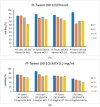Chemotherapeutic Drug Delivery Nanoplatform Development: From Physicochemical to Preclinical Evaluation
- PMID: 39519074
- PMCID: PMC11546407
- DOI: 10.3390/ijms252111520
Chemotherapeutic Drug Delivery Nanoplatform Development: From Physicochemical to Preclinical Evaluation
Abstract
Through this study, the synergistic behavior of small-molecular-weight, amphiphilic surfactant molecules and the triblock copolymer Pluronic 188 was extensively evaluated based on their ability to formulate nanocarriers with novel properties for the delivery of class II and IV (biopharmaceutical classification system) chemotherapeutic compounds. The combination of four different surfactants at multiple weight ratios and twelve initially formulated nanosystems resulted in four hybrid delivery platforms, which were further studied in terms of multiple physicochemical characteristics, as well as their stability in protein-rich media (fetal bovine serum/phosphate-buffer saline). Finally, we obtained a single final nanoformulation that exhibited a high loading capacity (%EE ≥ 75%) and a sustained drug release profile under physiological conditions (model drug methotrexate), without altering the original physicochemical characteristics of the carrier. With a mean hydrodynamic radius (Rh) of less than 70 nm, a polydispersity index of 0.219, and no protein complexation, the system is a suitable candidate for in vivo, intravenous, and/or intramuscular administration. The cytotoxicity and genotoxicity of both loaded and unloaded carriers were evaluated through the examination of the upregulation or downregulation of apoptosis-related pathways. Multiple conventional 2D and 3D spheroidal conformations were used for these assessments, including HEK293, HCT-116, and MCF-7 cell lines, the results of which stressed the safety and biocompatibility of the empty nanocarrier. Additionally, experiments on Caenorhabditis elegans were conducted to evaluate the system's in vivo toxicity, focusing on developmental stages, egg-laying behavior, and locomotion. Nanosystems studied in terms of chemotherapeutic encapsulation have mostly focused on the physiochemical aspect of the development of such novel delivery platforms, with only few exceptions proceeding step-by-step from cellular 2D to 3D to in vivo experimentation. The present study offers a holistic view of the behavior of such a novel system, advancing our understanding of the capabilities of polymeric/surfactant-based nanodelivery platforms.
Keywords: 3D cell culture; C. elegans; MTS assay; Pluronic 188; real-time PCR; thin-film hydration.
Conflict of interest statement
The authors report no conflicts of interest.
Figures













Similar articles
-
Non-Ionic Surfactant Effects on Innate Pluronic 188 Behavior: Interactions, and Physicochemical and Biocompatibility Studies.Int J Mol Sci. 2022 Nov 10;23(22):13814. doi: 10.3390/ijms232213814. Int J Mol Sci. 2022. PMID: 36430294 Free PMC article.
-
A Carrier-Free Folate Receptor-Targeted Ursolic Acid/Methotrexate Nanodelivery System for Synergetic Anticancer Therapy.Int J Nanomedicine. 2021 Mar 3;16:1775-1787. doi: 10.2147/IJN.S287806. eCollection 2021. Int J Nanomedicine. 2021. PMID: 33692622 Free PMC article.
-
Amphiphilic Y shaped miktoarm star copolymer for anticancer hydrophobic and hydrophilic drugs codelivery: Synthesis, characterization, in vitro, and in vivo biocompatibility study.J Biomed Mater Res A. 2018 Nov;106(11):2817-2826. doi: 10.1002/jbm.a.36468. Epub 2018 Aug 27. J Biomed Mater Res A. 2018. PMID: 29908009
-
Synergistic effect of curcumin and tamoxifen loaded in pH-responsive gemini surfactant nanoparticles on breast cancer cells.BMC Complement Med Ther. 2024 Sep 20;24(1):337. doi: 10.1186/s12906-024-04631-x. BMC Complement Med Ther. 2024. PMID: 39304876 Free PMC article.
-
Advanced targeted therapies in cancer: Drug nanocarriers, the future of chemotherapy.Eur J Pharm Biopharm. 2015 Jun;93:52-79. doi: 10.1016/j.ejpb.2015.03.018. Epub 2015 Mar 23. Eur J Pharm Biopharm. 2015. PMID: 25813885 Review.
References
-
- Alexandridis P. In: Amphiphilic Block Copolymers: Self-Assembly and Applications. 1st ed. Lindman B., editor. Elsevier Science & Technology; Oxford, UK: 2014.
-
- Rodríguez-Hernández J. Recent Developments in Polymer Macro, Micro and Nano Blends. Elsevier; New York, NY, USA: 2017. Micro-/Nanostructured Polymer Blends Containing Block Copolymers; pp. 131–161.
MeSH terms
Substances
LinkOut - more resources
Full Text Sources

